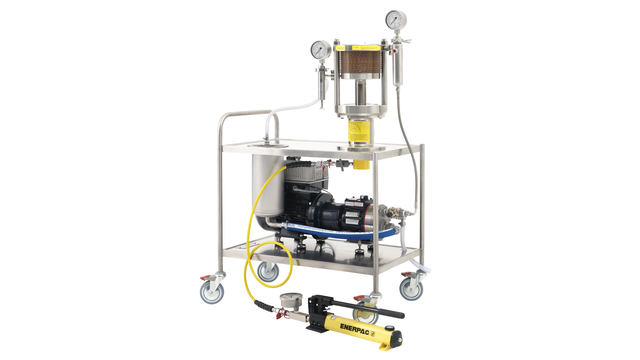TestUnit M20
The Alfa Laval TestUnit M20 is a fully integrated plate-and-frame system for research and development, educational work, process optimization and up-scaling, quality assurance and small-scale production. An optional M20-2.5” housing makes this wheeled unit easily convertible also for spiral wound operation. The Alfa Laval TestUnit M20 can be equipped with our entire range of flat sheet and spiral membranes for reverse osmosis, nanofiltration, ultrafiltration and microfiltration
The Alfa Laval TestUnit M20 is designed to provide quick and precise test results, while keeping equipment and set-up costs to a minimum.
The unit is a fully integrated and wheeled system comprising an Alfa Laval LabStak® M20, high-pressure pump, tank, heat exchanger, valve, pressure gauges and hydraulic hand pump for module compression.
The Alfa Laval TestUnit M20 can be fitted with the entire range of flat sheet membranes for reverse osmosis, nanofiltration, ultrafiltration and microfiltration available from Alfa Laval. With the optional Alfa Laval Lab M20-2.5" housing it is possible to test also spiral membranes.
Option
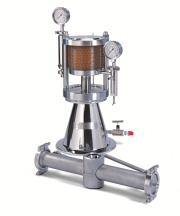 For the Alfa Laval TestUnit M20 we offer a specially designed Alfa Laval Lab M20-2.5" housing which can be inserted between the module flanges of the Alfa Laval LabStak® M20.
For the Alfa Laval TestUnit M20 we offer a specially designed Alfa Laval Lab M20-2.5" housing which can be inserted between the module flanges of the Alfa Laval LabStak® M20.
This special housing makes the Alfa Laval TestUnit M20 easily convertible into a spiral membrane test unit for sanitary full-fit 2.5" spiral membranes. A unique combination of plate-and-frame and spiral wound technologies in one unit.
Alfa Laval LabStak® M20
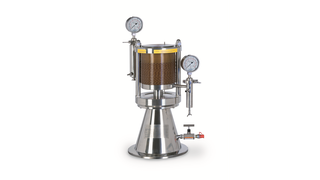 The Alfa Laval LabStak® M20 mounted in the Alfa Laval TestUnit M20 is also available as a separate test unit for the same applications as the Alfa Laval TestUnit M20, and with the same distinct properties.
The Alfa Laval LabStak® M20 mounted in the Alfa Laval TestUnit M20 is also available as a separate test unit for the same applications as the Alfa Laval TestUnit M20, and with the same distinct properties.
Alfa Laval LabUnit M20
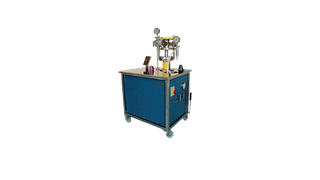 The Alfa Laval LabUnit M20 is a fully integrated system contained in a closed and wheeled cabinet holding the Alfa Laval LabStak® M20 and other basic components.
The Alfa Laval LabUnit M20 is a fully integrated system contained in a closed and wheeled cabinet holding the Alfa Laval LabStak® M20 and other basic components.
Benefits
- fully integrated system with module, pump, heat exchanger, valve, pressure gauges and hydraulic hand pump
- flexible membrane areas from 0.036 m² to 0.72 m²
- simultaneous test of different membrane types
- multiple purposes - possibility of combining plate-and-frame and spiral wound designs in one unit with optional 2.5" housing
- easy exchange of spiral and flat sheet membranes
- separate permeate outlet from each individual membrane pair
- high operating temperature and pressure
- variation of cross-flow from 5 to 24 l/min.
- compact and space-saving design
- all components in compliance with FDA and EEC regulations, allowing use within food and pharmaceutical processing applications
Hoe het werkt
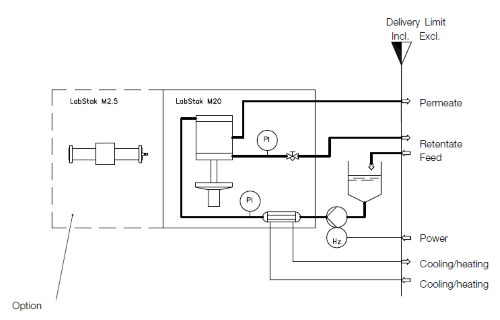
Physical separation
Membrane filtration is a physical separation process in which the driving force is the difference in pressure between the two sides of a special membrane. This process is characterized by the ability to separate molecules of different sizes and characteristics.
Almost all industrial membrane filtration is carried out as cross-flow filtration, where the liquid being filtered flows parallel to the membrane at high velocity and under pressure.
Physical barrier
In its most basic terms, membrane filtration involves passing a single feed stream through a membrane system that separates it into two individual streams, known as the permeate and the retentate. The membrane that separates them is a physical barrier with highly specialized characteristics - a barrier that only certain selected components in the feed stream can pass through.
Passing through
The pores of such membrane material are so small that they are measured in Angstrom (10-10 m), and pressure is required to force the liquid through them. In fact, the pores in the membranes used for nanofiltration and reverse osmosis are so small that they cannot be seen even with a scanning electron microscope.

